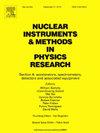Cosmic ray test of a full-sized DTOF detector prototype for the STCF experiment
IF 1.5
3区 物理与天体物理
Q3 INSTRUMENTS & INSTRUMENTATION
Nuclear Instruments & Methods in Physics Research Section A-accelerators Spectrometers Detectors and Associated Equipment
Pub Date : 2025-06-05
DOI:10.1016/j.nima.2025.170716
引用次数: 0
Abstract
A DTOF detector—a time-of-flight (TOF) detector based on internally reflected Cherenkov light detection (DIRC)—has been proposed for endcap particle identification (PID) in the experiment at the Super Tau-Charm Facility (STCF). To validate the design and performance of the DTOF detector, a prototype of a complete quadrant of the DTOF endcap disc featuring a fan-shaped planar fused silica radiator coupled with an array of MCP-PMTs was constructed. The radiator can be viewed as a combination of 3 trapezoidal units, each measuring 533 mm/295 mm × 454 mm × 15 mm. The prototype was tested in a cosmic ray telescope, which provided 3D tracking of cosmic ray muons and a reference time resolution of approximately 20 ps. The test results showed that the DTOF prototype could achieve a particle detection efficiency exceeding 98 %, with a single-photon time resolution of 60 ps and a single-track time resolution of 22 ps. These results are consistent with those from Geant4-based simulation. The prototype also showed consistent performance in different regions in the test. The work on the DTOF prototype has indicated that the DTOF design can achieve the expected performance.
用于STCF实验的全尺寸dof探测器原型的宇宙射线测试
提出了一种基于内反射切伦科夫光探测(DIRC)的飞行时间探测器(TOF),用于超级Tau-Charm设施(STCF)的末端粒子识别(PID)实验。为了验证dof探测器的设计和性能,构建了一个具有扇形平面熔融硅散热器和mcp - pmt阵列耦合的dof端盖圆盘完整象限的原型。散热器可以看作是3个梯形单元的组合,每个单元的尺寸为533毫米/295毫米× 454毫米× 15毫米。在提供宇宙射线μ子三维跟踪、参考时间分辨率约为20 ps的宇宙射线望远镜中对原型机进行了测试,测试结果表明,dof原型机的粒子检测效率超过98%,单光子时间分辨率为60 ps,单轨道时间分辨率为22 ps,与基于geant4的仿真结果一致。在测试中,原型机在不同区域也表现出一致的性能。对dof样机的研究表明,dof设计可以达到预期的性能。
本文章由计算机程序翻译,如有差异,请以英文原文为准。
求助全文
约1分钟内获得全文
求助全文
来源期刊
CiteScore
3.20
自引率
21.40%
发文量
787
审稿时长
1 months
期刊介绍:
Section A of Nuclear Instruments and Methods in Physics Research publishes papers on design, manufacturing and performance of scientific instruments with an emphasis on large scale facilities. This includes the development of particle accelerators, ion sources, beam transport systems and target arrangements as well as the use of secondary phenomena such as synchrotron radiation and free electron lasers. It also includes all types of instrumentation for the detection and spectrometry of radiations from high energy processes and nuclear decays, as well as instrumentation for experiments at nuclear reactors. Specialized electronics for nuclear and other types of spectrometry as well as computerization of measurements and control systems in this area also find their place in the A section.
Theoretical as well as experimental papers are accepted.

 求助内容:
求助内容: 应助结果提醒方式:
应助结果提醒方式:


